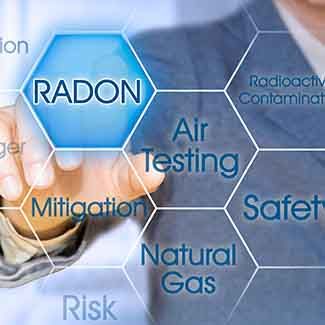Since the arrival of COVID-19, we have all spent much more time at home. This has led to an increased risk of exposure to radon, which is why the Canadian government is advising every household to test their home for radon.
What is Radon?
As uranium, thorium, and radium break down in the soil, rocks, and water, they create radon gas. Outdoors, radon levels generally remain low as the gas dissipates into the air. Nothing too dangerous about that, you might think. However, radon is radioactive, and it can find its way into your home, seeping up from the soil through the cracks and holes in your house foundations. It can also contaminate water supplies, further increasing your risk of exposure.
Radon Facts
- Radon is the #1 cause of lung cancer in nonsmokers.
- As many as 1 in 15 homes in the US have high radon levels.
- Radon is colorless, odorless, and tasteless.
Testing Is the Only Way to Know
Symptoms of radon exposure may occur years later, making it almost impossible to detect without carrying out a specific test. Furthermore, radon levels can fluctuate over time, so short-term tests are fairly limited. Testing over a longer period will give a more accurate result. This is why the Canadian government encourages households to purchase long-term radon test kits. Tests are carried out over three months and then sent to the lab. If your home measures less than 200Bq/m3 (that’s becquerels per cubic meter), no further action is required. If your test results show a high reading, you are advised to contact the radon helpline at 1-833-723-6600 or visit www.canada.ca/radon
What’s Next?
There are several types of radon reduction systems, depending on your home type. This guide from the EPA explains the various options available.
Do air purifiers help?
For complete peace of mind, you may also want to consider investing in an air purifier to remove any Radon decay products. When radon gas breaks down, it creates pollutants known as ‘Radon Daughters’ or ‘Radon Progeny.’ These pollutants attach themselves to dust particles that can cause lung cancer when inhaled.
Activated Carbon Filters
Where HEPA filters are preferred to remove most of the allergens, it’s the “Activated Carbon” filter that matters more in dealing with Radon.
Carbon activated filters contain porous carbon that work to trap odors and gasses passing through the filter. Some are strong enough to remove volatile organic compounds and larger particles too.
When it comes to eliminating smells and gasses in your home, an activated carbon filter is a great solution.
So, do air purifiers help with radon? Yes they do! But only with the help of activated carbon
Running an Austin Air purifier with the activated carbon filter will help to remove ‘Radon Progeny/Daughters’ from the air and improve your indoor air quality*.
For more info on our complete range of air purifiers for your home, visit our SHOP page today or contact one of the team at 1-800-724-8403 or email us at info@austinair.com we’re always happy to help!
*Please note. For the effective and safe removal of radon from your home, we would always recommend using an indoor air professional for radon mitigation.
